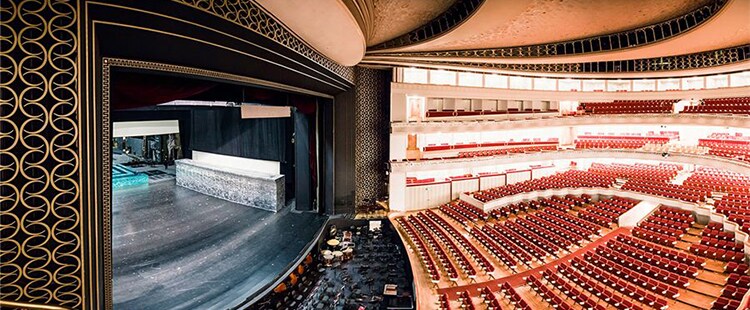ACOUSTICS PART TWO: ACOUSTIC ENHANCEMENT.

Building a concert hall for a certain kind of performance has the advantage that the architect can optimise the interior shapes and surfaces to provide a perfect acoustic environment. 100 fine examples are described by Leo Beranek in his book ‘Concert Halls and Opera Houses’. However, for most venues the economy of scale dictates that several kinds of performances should be possible: from a singer-songwriter with acoustic guitar in the middle of the stage up to a full philharmonic orchestra.
Introducing variability is possible by mechanical means: for example a variable height roof, turn-over wall elements with reflective and absorptive surfaces or doors to adjacent reverberation chambers. All are viable solutions, but very expensive and often requiring multiple staff members and a lot of time to make the change.
In 1969, a Dutch company, who already experimented with variable acoustics using endless tape machines in he fifties, finally nailed it. Phillips filed a patent on ‘Multiple Channel Reverberation’ (MCR), based on the premise that feedback between a microphone and a speaker placed in the same acoustic space is very unlikely if the total power loop gain is less then -12dB and ‘howling’ is not noticeable with loop gains of less than -21dB. By carefully applying multiple independent channels, each with -21dB loop gain but with different ‘mode’ frequencies, Philips could greatly increase the total acoustic energy in a space without howling. This ‘regeneration’ of acoustic energy allows for a moderate increase in reverberation times, leading to a very natural-sounding result and, in the 1970s, MCR was applied in many concert halls.
The advantage of ‘regenerative’ systems is that they use omni-directional microphones placed in the ceiling, so the system responds to sounds everywhere in the hall - just as with natural acoustics. The disadvantage is that the system is based on increasing acoustic energy, inducing ‘bathroom’ effects at high energy levels. Also, regeneration means that if the hall sounds bad to begin with, a regenerative system only makes it worse.
In the late 1980s, the Dutch company ACS and the US company Lexicon introduced ‘in-line’ systems, based on the generation of a reverberation field in a relatively dry room by means of digital reverberation algorithms. These systems were designed to prevent feedback as much as possible by applying directional microphones on the stage, playing the reverberation field only to the audience. The advantage of these systems is the high degree of freedom to design a perfect reverberation pattern, not affected by acoustic feedback. However, the disadvantage is that it only works for sound on the stage. Sound in the audience area is not enhanced and the enhancement doesn't include the stage, so performers can not benefit - they still play on an acoustically dry stage.
At the same time, Yamaha (AFC3), and later LCS (VRAS, later renamed Constellation), took a different route, developing the MCR concept a step further. Both systems apply digital reverberators in the feedback loops to achieve longer reverberation times with lower energy, using less independent channels. This ‘hybrid regenerative’ approach offers the best of both worlds: the natural response of a regenerative system, responding to sounds in the whole hall, and the freedom of in-line systems to adjust the existing acoustic fingerprint, supporting very long reverberation times without getting too loud.
The many DSP technology advancements in the past 10 years have led to very high quality acoustic enhancement results, at the same time reducing system costs so that the application of an electro-acoustic solution is many times less expensive when compared to a variable architecture solution.